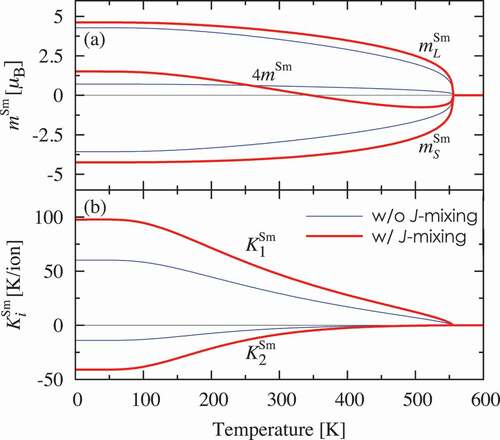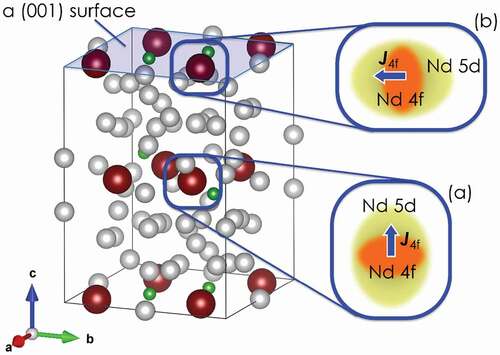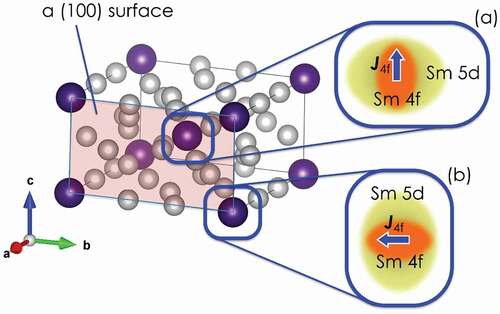 ?Mathematical formulae have been encoded as MathML and are displayed in this HTML version using MathJax in order to improve their display. Uncheck the box to turn MathJax off. This feature requires Javascript. Click on a formula to zoom.
?Mathematical formulae have been encoded as MathML and are displayed in this HTML version using MathJax in order to improve their display. Uncheck the box to turn MathJax off. This feature requires Javascript. Click on a formula to zoom.ABSTRACT
It has been empirically known that the coercivity of rare-earth permanent magnets depends on the size and shape of fine particles of the main phase in the system. Also, recent experimental observations have suggested that the atomic-scale structures around the grain-boundaries of the fine particles play a crucial role to determine their switching fields. In this article, we review a theoretical attempt to describe the finite temperature magnetic properties and to evaluate the reduction of the switching fields of fine particles of several rare-earth permanent magnetic materials based on an atomistic spin model that is constructed using first-principles calculations. It is shown that, over a wide temperature range, the spin model gives a good description of the magnetization curves of rare-earth intermetallic compounds such as R2Fe14B (R= Dy, Ho, Pr, Nd, Sm) and SmFe12. The atomistic spin model approach is also used to describe the local magnetic anisotropy around the surfaces of the fine particles, and predicts that the rare-earth ions may exhibit planar magnetic anisotropy when they are on the crystalline-structure surfaces of the particles. The dynamical simulation of the atomistic spin model and the corresponding micromagnetic simulation show that the planar surface magnetic anisotropy causes a reduction in the switching field of fine particles by approximately 20–30%, which may be relevant to the atomic-scale surface effects found in the experimental studies.
Graphical abstract
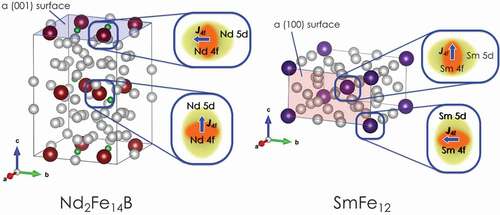
1. Introduction
Since the discovery of SmCo-based magnets, the magnetic properties of rare-earth intermetallic compounds have garnered practical interest and become a subject of theoretical research in fundamental physics. To date, several other permanent magnetic materials have been employed in practical applications, such as Nd2Fe14B, Sm2Co17, and Sm
Fe
N
. Furthermore, SmFe
has recently attracted significant attention as a promising candidate for new permanent magnetic materials. Many studies on these rare-earth-based materials have been conducted, and the progress in experimental studies is particularly remarkable. However, the theoretical understanding of coercivity in these materials is insufficient to quantitatively describe the coercive force of existing permanent magnets or to predict the magnetization reversal processes in new permanent magnets. This is owing to the difficulties in the theoretical analysis of the hysteresis phenomena, which involve multi-scale physical mechanisms.
At this stage, an important theoretical issue that needs to be addressed is the construction of a model that can accurately describe the equilibrium magnetic properties of rare-earth-based magnetic materials. First-principles calculation techniques provide the best descriptions of the electron states of materials. However, this approach only yields results at a temperature of absolute zero. Moreover, even modern first-principles calculation techniques are limited when considering 4f electrons, and some additional corrections, such as the LDA method or the self-interaction correction (SIC), are required. Nevertheless, a convenient and reasonably reliable method exists for materials that contain well-localized 4f electrons. This method is to estimate magnetocrystalline anisotropy via the crystal field theory, based on first-principles calculations using the so-called open-core method [Citation1]. An effective spin model can then be constructed, which includes the crystal field Hamiltonian for rare-earth ions to describe the finite temperature magnetic properties of rare-earth-based magnetic materials [Citation2]. Intuitively, this method performs better for materials with heavier rare-earth elements, because their 4f electrons are more localized, known as lanthanide contraction. We recently identified that this method provides a quantitatively satisfactory description of finite temperature magnetic properties, especially for heavier rare-earth compounds, such as Ho
Fe
B and Dy
Fe
[Citation3]. However, it yields somewhat limited descriptions for lighter rare-earth elements, where 4f localization is not sufficiently guaranteed. We review the present status of these model calculations later.
Subsequent to the development of an effective spin model, the next task that needs to be addressed is establishing a description of the magnetization reversal processes. Recently, a series of experimental studies on Nd-Fe-B sintered magnets [Citation4] and Sm(FeCo
)
thin films [Citation5] revealed that the atomic-scale structure and elemental distribution around the grain boundaries in these materials have a significant influence on their coercivity. This implies that the local electron state around the surfaces of fine particles is an important factor that affects the switching fields of these materials. Thus, a detailed study of the electron states around the surfaces is expected to improve the theoretical understanding of the switching field, and thus, the coercivity. We believe that the effective spin model is suitable for describing local magnetic properties around surfaces at the atomic scale.
Motivated by the abovementioned experimental observations, several studies have investigated local electron states of the (001) and (100) surfaces of crystalline Nd2Fe14B based on first-principles calculations. The results showed that Nd ions located on the (001) surface of Nd2Fe14B not only lose their uniaxial magnetic anisotropy but also exhibit strong planar anisotropy [Citation6–8]. Atomistic spin dynamics simulations were also used to identify that the switching field of a Nd2Fe14B fine particle is reduced by 70% of the anisotropy field HA, owing to the local planar magnetic anisotropy around the (001) surface [Citation2,Citation9].
In this study, we first briefly review the current status of methods used to develop the effective spin model of rare-earth intermetallic compounds based on first-principles calculations. Subsequently, we review the surface magnetic anisotropy of crystalline Nd2Fe14B, and we investigate the same problem for SmFe12. We show that the local magnetic anisotropy around the surfaces of these two systems differs significantly. We then consider the switching fields of the fine particles of both systems using the atomistic spin dynamics simulation method. Finally, we discuss the dependence of the switching fields on the particle size based on the micromagnetic simulation technique [Citation10,Citation11], where the parameters are derived by applying a coarse grain to the atomistic spin model.
2. A model Hamiltonian
The standard model for describing the contribution of the 4f orbital to the magnetocrystalline anisotropy energy is a rare-earth single-ion Hamiltonian [Citation1], and that for the i-th ion in the crystal is given as [Citation12]
where is the orbital (spin) moment,
is the molecular field at a finite temperature
,
is the crystal field (CF) parameter,
is the tesseral harmonic function,
and
are angle operators for the j-th 4f electron, and
is the numerical factor [Citation13]. The summation for j is taken over the 4f electrons, the total number of which is denoted by
. If we project this Hamiltonian onto the lowest
subspace, the truncated Hamiltonian is expressed as
where is the total angular momentum,
is the Lande g-factor, and
and
are the Stevens factor and operators, respectively [Citation14]. The CF Hamiltonian for the
electrons is the last term of EquationEquations (1)
(1)
(1) and (Equation2
(2)
(2) ).
According to previous studies by Novák and Diviš [Citation15–17], the CF coefficients are given by
where is the component of the total Coulomb potential of a rare-earth ion within an atomic sphere of radius
.
describes the radial shape of the localized 4f charge density of rare-earth ions.
In rare-earth permanent magnetic materials, the second term of (2) is much smaller than the first term. Thus, one may assume that the magnetic moments of the rare-earth and 3 transition metal ions are parallel. Under this assumption, we can equate the local anisotropy energy of the
-th
ion with the single ion-free energy defined by the Hamiltonian (2) given as
Using the above , the free energy of the effective spin model is expressed as [Citation2]
where is the magnetic moment of the
-th
(Fe) ion at finite temperatures,
is the exchange coupling constant between moments on the
and
ions, and
is the external magnetic field. The atomistic Landau-Lifshitz-Gilbert (LLG)-type equation is obtained as
with
where represents
or Fe, and
is the gyromagnetic ratio of the
-th ion.
Using symmetry considerations, for the Sm ions on the (100) surface can be expanded as follows:
Practically, the coefficients can be estimated via a comparison between the Taylor series expansion of EquationEquations (4)
(4)
(4) and (Equation8
(8)
(8) ) [Citation18]. We confirmed that the third and subsequent terms on the right-hand side of EquationEquation (8)
(8)
(8) are negligibly small for higher temperatures, i.e.
K. Thus, in the LLG simulation, we consider up to the second term of EquationEquation (8)
(8)
(8) .
By contrast, using Kuz’min’s linear theory [Citation19], we obtain analytical expressions for anisotropy constants as follows:
where is the generalized Brillouin function [Citation19] with
.
3. Bulk magnetic properties
We first investigate the bulk magnetic properties under equilibrium, obtained via effective spin models, for several rare-earth intermetallic compounds. The emphasis in this study is on a physical discussion; mathematical and numerical details are available in existing literature [Citation2,Citation3,Citation8,Citation20,Citation21].
3.1. 
 Fe
Fe
 B systems
B systems
Because Fe
B systems can be synthesized for almost all rare-earth elements, we compare their magnetic properties with respect to the differences between rare-earth elements. This is a convenient approach to confirm the validity of the effective spin model method.
Recently, the first two authors of this review confirmed that the effective spin model description performs well for heavier rare-earth intermetallic compounds DyFe
B and Ho
Fe
B [Citation3]. shows the magnetization curves of these materials along the [001] and [110] axes at
K. The solid and broken lines depict theoretical results obtained using the effective spin model, whereas the filled circles depict experimental data reproduced from [Citation12]. We observe that the theoretical and experimental results are in very good agreement, which suggests the validity of the effective spin model for these compounds. Notably, the magnetization along the [110] direction is zero for Dy
Fe
B in the absence of an external magnetic field but non-zero for Ho
Fe
B. This is a manifestation of the so-called spin-reorientation phenomenon, which is only observed in Ho
Fe
B for these two materials. We further confirmed that the temperature dependence of the tilt angle of the magnetization under the zero-field in Ho
Fe
B is also well described by the effective spin model [Citation3]. Thus, we may conclude that the effective spin model successfully describes the finite temperature magnetic properties of Dy
Fe
B and Ho
Fe
B, and reflects the differences in rare-earth elements.
Figure 1. Magnetization curves of Fe
B (
=Dy, Ho). Solid and broken lines represent the results calculated using the molecular field
determined from the experimental results [Citation22] and the first-principles calculations, respectively. Filled circles represent experimental results reproduced from [Citation12]. (Reprinted with permission from [Citation3]. Copyright 2018 by the American Physical Society.)
![Figure 1. Magnetization curves of R2Fe 14B (R=Dy, Ho). Solid and broken lines represent the results calculated using the molecular field Hm determined from the experimental results [Citation22] and the first-principles calculations, respectively. Filled circles represent experimental results reproduced from [Citation12]. (Reprinted with permission from [Citation3]. Copyright 2018 by the American Physical Society.)](/cms/asset/8044c31a-9c37-484b-bc74-a3c75ddc73fc/tsta_a_1947119_f0001_oc.jpg)
Next, we consider the results for Fe
B with lighter rare-earth elements, such as
Pr, Nd, and Sm. shows the magnetization curves of these materials along the [001], [100], and [110] directions at
K. Here, the solid lines represent theoretical results, and the open symbols represent the experimental results reproduced from [Citation12]. The effective spin model is in good agreement with the experimental results only for Sm
Fe
B; for Pr
Fe
B and Nd
Fe
B, discrepancies with the experimental results are noted at a qualitative level, such as its failure to describe first-order magnetization processes (FOMP) along the [100] and [110] directions. This must be considered when applying the effective spin model to lighter rare-earth intermetallic compounds. However, we note that the behavior that cannot be described by the effective spin model, such as the FOMP, is observed only at low temperatures, and we have also confirmed that the effective spin model description is practically sufficient above room temperature.
Figure 2. Magnetization curves of Fe
B (
=Pr, Nd, Sm) along the [001] (red), [100] (green), and [110] (blue) axes. Open circles represent experimental results [Citation12]
![Figure 2. Magnetization curves of R2Fe 14B (R=Pr, Nd, Sm) along the [001] (red), [100] (green), and [110] (blue) axes. Open circles represent experimental results [Citation12]](/cms/asset/3cc19adb-ea91-4b24-9a18-d607b4e4bd1c/tsta_a_1947119_f0002_oc.jpg)
The spin model does not precisely describe the magnetic properties of lighter rare-earth intermetallic compounds at low temperatures, especially those of Pr and Nd, because 4f electrons of these ions are less tightly bound to the nucleus. This situation is clearly presented in , which shows the radial shapes of the 4f charge densities of Pr, Nd, Sm, Dy, and Ho, which were obtained through atomic calculations of the electron structures of isolated rare-earth atoms. In the case of these very light rare-earth elements, it is evident that the preconditions for applying the open-core method, which is the basis for constructing an effective spin model, are not completely satisfied. Therefore, a novel method to describe weakly localized 4f electrons is required to construct a CF Hamiltonian. A promising method was recently developed by one of the authors of this review (P. N). It was first applied to rare-earth aluminates or oxides, and it yielded excellent results [Citation23]. Making this method applicable to magnetic rare-earth intermetallic compounds is not a straightforward task; however, several attempts have been, and are still being, made [Citation24].
Figure 3. Radial 4f charge densities of Pr, Nd, Sm, Dy, and Ho, which were obtained by performing atomic calculations of the electron structure of isolated rare-earth atoms. In these calculations, the self-interaction correction (SIC) was included, which leads to a better approximation for the single electron densities. This approach provided a 4f charge density that was very close to that obtained using more rigorous SIC-DFT band calculations [Citation1]
![Figure 3. Radial 4f charge densities r2R4f2 of Pr, Nd, Sm, Dy, and Ho, which were obtained by performing atomic calculations of the electron structure of isolated rare-earth atoms. In these calculations, the self-interaction correction (SIC) was included, which leads to a better approximation for the single electron densities. This approach provided a 4f charge density that was very close to that obtained using more rigorous SIC-DFT band calculations [Citation1]](/cms/asset/4b87d954-0008-4bee-bc94-81b75f440960/tsta_a_1947119_f0003_oc.jpg)
3.2. SmFe12
There are three types of Sm compounds that are used as practical permanent magnetic materials, namely SmCo, Sm
Co
, and Sm
Fe
N
. Recently, SmFe
has attracted renewed interest as a candidate for a new rare-earth lean permanent magnetic material because it exhibits excellent intrinsic magnetic properties, such as uniaxial magnetic anisotropy. Thus, it is important to establish an effective spin model method for Sm-based intermetallic compounds for the future development of new permanent magnets.
Here, we return to the Hamiltonian for the effective spin model given in EquationEquations (1)(1)
(1) and (Equation2
(2)
(2) ). For free trivalent rare-earth ions, the low-lying electron states are well described by the Russell–Saunders coupling scheme. The orbital angular momentum
and spin
in the ground state are given by Hund’s rule; the total angular momentum
is
for light rare-earth elements. Because the spin-orbit coupling of the lanthanide 4f orbitals is strong (3000–15,000 K), only the ground state of the
-multiplet needs to be considered during the calculation. For such a case, we may use the truncated Hamiltonian (2). However, Eu
and Sm
are well-known exceptions, where the first excited state of the
-multiplet is at 366 and 1340 K above the ground state, respectively. Furthermore, when the ions are in a permanent magnet, the strong exchange field acting on the 4f electron spins leads to a mixture of states with different quantum numbers
, as shown in . Therefore, it is no longer possible to restrict the Hilbert space of the Hamiltonian to a subspace with the lowest
-multiplet, and the Hamiltonian in EquationEquation (1)
(1)
(1) must be used for the effective spin model of Sm-based compounds.
Figure 4. Calculated energy levels of the Sm 4f electron states in SmFe in the absence of an external magnetic field. The energy levels determined by the spin-orbit Hamiltonian
are split by the strong exchange field
, which acts on the spins of the 4f electrons, thereby resulting in the level crossing of states with different quantum numbers
. However, the CF Hamiltonian
only slightly shifts these energy levels

Next, let us examine the differences between the two Hamiltonians (1) and (2) in the description of the magnetic properties; we use SmFe as an example. shows the temperature dependences of the orbital, spin, and total magnetic moments of the Sm ion and the magnetic anisotropy constant
and
for each Sm ion, which were calculated using the effective spin models with a truncated Hamiltonian (2) or an unrestricted one (1). The results show that the
-mixing effects increase the absolute values of both
and
over the entire temperature range. We observe that the total magnetic moment of the Sm ion
is reversed at approximately
K. Notably, the effective spin model with an unrestricted Hamiltonian (1) provides good descriptions for the finite temperature magnetic properties of SmFe
and Sm
Fe
N
, as reported in [Citation25] and [Citation26], respectively.
4. Surface magnetic properties
In this section, we discuss the surface magnetic anisotropy of the crystalline NdFe
B and SmFe
, and we estimate the switching field of the fine particles of these materials. First, we consider the CF parameters
of rare-earth ions in Nd
Fe
B and SmFe
, which are calculated using (3) on the basis of first-principles calculations in the following two subsections. To obtain
and
in (3), we use the full-potential linearized augmented plane-wave plus local orbital method (APW+lo), which was implemented using WIEN2k code [Citation27]. Furthermore, we carry out separate atomic calculations of the electron structure of isolated Nd and Sm atoms using the same approach as that in our previous study. Here, the lattice constants of the primitive cell are set to the experimental values of
Å and
Å for Nd
Fe
B [Citation28], and
Å and
Å for SmFe
[Citation29]. Throughout this study, we use
,
, and
a.u. for the Nd, Fe, and B ions in Nd
Fe
B, respectively, and
and
a.u. for the Sm and Fe ions in SmFe
, respectively. The computational details are provided in Ref [Citation2].
4.1. Nd
 Fe
Fe
 B
B
In , we summarize the CF parameter of the Nd ions in the bulk system at the (100) and (001) surfaces of the Nd
Fe
B structure [Citation2,Citation8]. We observe that
is negative only when the Nd ion is on the (001) surface. Because
is the leading term of the CF parameters, its sign is the main factor that determines the magnetic anisotropy of rare-earth ions. A positive
indicates that the Nd ions exhibit uniaxial magnetic anisotropy. Therefore, we observe that Nd ions on the (001) surface exhibit planar magnetic anisotropy.
Table 1. CF parameter [K] of N
ions in the crystalline N
F
B structure
We now discuss the physical reason for the planar magnetic anisotropy of Nd ions on the (001) surface. Intuitively, the uniaxial magnetic anisotropy of NdFe
B along the
-axis can be explained as follows. In the Nd
Fe
B structure, the nearest-neighboring ions of each Nd ion are the Fe ions located in the direction slightly tilted from the
-axis, as observed from the Nd ion. Thus, 5d or 6p valence electrons of the Nd ions are primarily exchange-coupled with 3d electrons of this Fe, which results in a slightly extended distribution of valence electrons along the
-axis. Then, the 4f electron cloud of the Nd ion tends to avoid any overlap with the prolate valence electron clouds to reduce the electrostatic energy between them; it also has a slightly flat distribution along the
-axis, as shown in the inset (a) of . The magnetic moment
of the 4f electrons is also depicted by a thick blue arrow in the same inset. Thus, this magnetic moment is energetically favorable when it is directed toward the
-axis. This is an intuitive explanation of the
-axis magnetic anisotropy of Nd ions in the Nd
Fe
B structure.
This scenario also holds when Nd ions are on the (100) surface, because neighboring Fe ions exist for each Nd ion on these surfaces. However, if an Nd ion is exposed to the (001) surface, it loses the nearest-neighboring Fe ions. Thus, the valence charge distribution of the Nd ion shifts from prolate to oblate to hybridize with the orbitals of the next-nearest ions, which results in planar magnetic anisotropy, as shown in the magnified image of inset (b) in .
4.2. SmFe12
Next, we investigate the CF parameters of Sm ions in the bulk system on both the (100) and (001) surfaces of SmFe
. We list
up to the fourth order in . Here, we observe that the leading term
is negative when Sm ions are in the bulk system and at the (001) surface. Because the sign of the second-order Stevens factor of Sm
is positive, the negative
value indicates that Sm ions exhibit uniaxial magnetic anisotropy along the
-axis. For the (100) surface, we note that
is positive and that some additional terms of
appear (that is,
and
) owing to the breaking of the original I4/mmm symmetry. Interestingly,
has a fairly large negative value. We note that this term affects the anisotropy parameter
in (9) via
in (13), and it contributes to the planar magnetic anisotropy of Sm ions on the (100) surface.
Table 2. CF parameter [K] of the Sm ions in SmFe
, which were obtained using first-principles calculations
We provide an intuitive explanation for the planar magnetic anisotropy of Sm ions on the (100) surface, as in the NdFe
B case. In the ThMn
structure, the nearest-neighboring ions of each Sm ion are the Fe ions on the so-called
-site in the same
-plane. Thus, the valence electron cloud of Sm ions has an oblate distribution, and the 4f electron cloud with a positive Stevens factor tends to extend along the
-axis to avoid overlapping with the valence electron cloud, as shown in the inset (a) of . This situation is reversed if Sm ions are on the (100) surface.
4.3. Surface magnetic anisotropy and switching fields
We discuss the surface magnetic anisotropy owing to the planar local anisotropy, which is caused by surface Nd or Sm ions. We compute the magnetic anisotropy energy of a unit cell including two formula units (f.u.) of NdFe
B or SmFe
based on EquationEquation (8)
(8)
(8) by using the information presented in the previous two subsections.
shows the magnetic anisotropy constant of each unit cell on (a) the (001) surfaces and (b) the (100) surfaces, as well as inside the materials, as a function of temperature. In , we clearly observe that the
value of the Nd
Fe
B unit cell on the (001) surface decreases significantly and becomes negative at all temperatures. By contrast, the
value of the SmFe
unit cell increases when the unit cell is on the (001) surface; however, it decreases on the (100) surface, which is expected from the
of the Sm ions on these surfaces, as shown in .
Figure 8. Magnetic anisotropy constants of each unit cell including two f.u. of NdFe
B (blue) or SmFe
(red) as a function of temperature.
is negative for (a) the unit cell of Nd
Fe
B on the (001) surface and for (b)
of SmFe
on the (100) surface
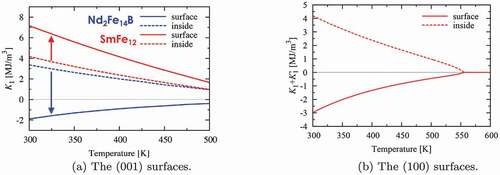
The surface magnetic anisotropy with negative , as described above, may be partly responsible for a reduction of the switching field of a Nd
Fe
B or SmFe
fine particle. In a previous study, we showed that for Nd
Fe
B, such surface magnetic anisotropy does indeed reduce the switching field by approximately 30% [Citation2]. Here, we investigate the same effects for SmFe
. First, we use the atomistic spin model, which was introduced in Section 2, to estimate the switching field of a small cluster of SmFe
by solving EquationEquation (7)
(7)
(7) . The magnetization curve obtained at
K is shown in . The black line represents the magnetization curve without the surface effects and the demagnetization effects. If we consider the planar magnetic anisotropy of the Sm ions on the (100) surface, we obtain the magnetization curve shown by the red line. This figure shows that the reduction of the SmFe
switching field by surface effects is approximately 30%.
Figure 9. The magnetization curves of a SmFe fine particle obtained using the atomistic spin model at
K. It can be observed that the switching field is reduced to approximately 70% of the anisotropy field when the surface effect is considered (red line)
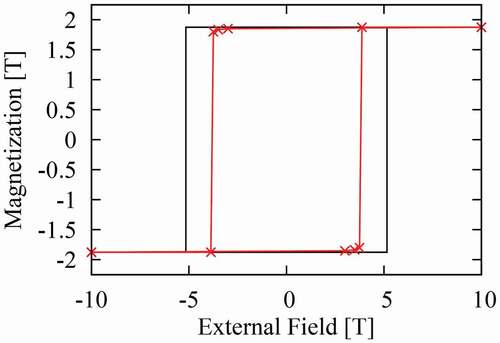
However, it is intuitive to suspect that the surface effects may disappear as the system size increases. Therefore, we study the size dependence of the switching field reduction, owing to the surface magnetic anisotropy effects. To this end, the atomistic spin model is not useful because it has excessive spin degrees of freedom, and it requires significant computational resources to simulate the magnetization reversal processes of a fine particle larger than a few tens of nanometers. Therefore, a coarse-grained model is required for this simulation. Establishing a general method to develop a coarse-grained atomistic spin model is a major challenge. Here, we make a simple and approximate attempt to obtain a coarse-grained micromagnetic model. A single SmFe unit cell is approximately the same size as the numerical unit cell in modern micromagnetic simulation models; thus, we use the anisotropy constant
shown in as a model parameter in the present micromagnetic simulation. For micromagnetic energy minimization [Citation30], the total Gibbs free energy is augmented with a surface energy term. Here, we only show the results of the size dependence of the switching field of a cubic micromagnetic model obtained via the present coarse-grain treatment. shows the switching field, or coercivity, of the cubic model as a function of the linear size of the system. We can clearly observe that the switching field is reduced by 20% only due to the surface effect, even if the system size is larger than 100 nm.
Figure 10. Size dependences of the switching field of a cubic model (i) without both the surface and the demagnetizing field effects, (ii) with only the demagnetizing field effect, (iii) with only the surface effect, and (iv) with both effects. We observe that the switching field is reduced by 20% due to the surface effect alone, even if the system size is larger than 100 nm
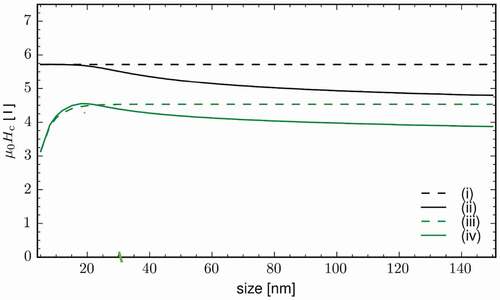
5. Summary
We present a review of rare-earth permanent magnetic materials, focusing on the theoretical aspects based on first-principles calculations and statistical mechanical analyses using the effective spin models. Equilibrium magnetic properties, such as the magnetization curves of Fe
B (
= Pr, Nd, Sm, Dy, Ho) and SmFe
, are well described by the effective spin model approach. Furthermore, we studied a possible reduction mechanism in the switching field of Nd
Fe
B or SmFe
fine particles, owing to the surface magnetic anisotropy, by using the atomistic spin model based on first-principles calculations and the continuum micromagnetic model. We confirmed that the switching field of these systems is reduced by 20% of the anisotropy field
, even when the system size is larger than 100 nm.
Acknowledgments
This work was supported by ESICMM Grant Number JPMXP0112101004, and ESICMM is funded by the Ministry of Education, Culture, Sports, Science and Technology (MEXT). The work of P. N. was supported by project SOLID21, and T. Y. was supported by JPS KAKENHI Grant Number JP18K04678. A. K., J. F., T. S., and H. T. acknowledge the support by the EU Horizon 2020 Program under grant number 686056 (Novamag). Some numerical computations were carried out at the Cyberscience Center, Tohoku University, Japan.
Disclosure statement
No potential conflict of interest was reported by the author(s).
Additional information
Funding
Notes on contributors
Hiroki Tsuchiura
Hiroki Tsuchiura received his PhD from Osaka University, Japan in 1997. After his postdoctoral studies at Nagoya University in Japan and also at SISSA in Trieste, Italy, he has joined Tohoku University since 2004. His research interests have been mainly lying in the field of superconductivity, topological materials. From 2008, he has been involved in several research projects for novel permanent magnets, as ESICMM in Japan and NOVAMAG of Horizon-2020 programme. Then theoretical studies on the magnetic properties of rare-earth based permanent magnets is one of his research interests.
Takuya Yoshioka
Takuya Yoshioka was born in Kyoto, Japan in 1978. He received his PhD in 2009 from Osaka University. After working as a research associate at Osaka University during 2009-2012, he has joined Tohoku University since 2013 as an assistant professor. His current research interest is the theoretical study of topological and magnetic materials.
Pavel Novák
Pavel Novák finished with distinction Faculty of Nuclear and Technical Physics, Czech Technical University, Prague in 1964. He received his PhD from Institute of Solid State Physics, Academic Society of Czech Republic (ASCR) in 1969. After working as a scientist at Department of Magnetic Oxides of Institute of Solid State Physics of ASCR, he has been a senior scientist at Department of Magnetism and Superconductivity in the Institute of Physics of ASCR since 1984. His research interests are the calculation of electronic structures of solids, and also of NMR and electronic transport phenomena.
Johann Fischbacher
Johann Fischbacher studied Computer simulation and mathematics and is currently matriculated at the TU Wien in a doctoral programme for technical physics. He works on micromagnetic simulations for permanent magnets at the Center for Modeling and Simulation, Danube University Krems, Austria.
Alexander Kovacs
Alexander Kovacs studied Computer simulation and is currently matriculated at TU Wien in a doctoral program for technical physics. He works on micromagnetic simulations for permanent magnets and sensor applications at the Center for Modeling and Simulation, Danube University Krems, Austria.
Thomas Schrefl
Thomas Schrefl received his PhD from the TU-Wien in 2002 where he completed his Habilitation in 1999 in “Computational Physics”. He worked on the development of numerical micromagnetic solvers for application in magnetic recording and permanent magnet. He is the head of the Center for Modelling and Simulation at Danube University Krems, Austria.
References
- Richter M. Band structure theory of magnetism in 3d-4f compounds. J Phys D: Appl Phys. 1998;31:1017–1048.
- Tsuchiura H, Yoshioka T, Noák P. Bridging atomistic magnetism and coercivity in Nd-Fe-B magnets. Scr Mater. 2018;154:248–252.
- Yoshioka T, Tsuchiura H. Site-specific magnetic anisotropies in R2Fe14B systems. Appl Phys Lett. 2018;112:162405.
- Hono K, Sepehri-Amin H. Strategy for high-coercivity Nd-Fe-B magnets. Scr Mater. 2012;67:530–535.
- Sepehri-Amin H, Tamazawa Y, Kambayashi M, et al. Achievement of high coercivity in Sm(Fe0.8Co0.2)12 anisotropic magnetic thin film by boron doping. Acta Mater. 2020;194:337–342.
- Moriya H, Tsuchiura H, Sakuma A. First principles calculation of CF parameter near surfaces of Nd2Fe14B. J Appl Phys. 2009;105:07A740.
- Tanaka S, Moriya H, Tsuchiura H, et al. First principles study on the local magnetic anisotropy near surfaces of Dy2Fe14B and Nd2Fe14B magnets. J Appl Phys. 2011;109:07A702.
- Tsuchiura H, Yoshioka T, Novák P. First-principles calculations of crystal field parameters of Nd ions near surfaces and interfaces in Nd-Fe-B magnets. IEEE Trans Magn. 2014;50:1–4.
- Mitsumata C, Tsuchiura H, Sakuma A. Model calculation of magnetization reversal process of hard magnet in Nd2Fe14B system. Appl Phys Express. 2011;4:113002.
- Fischbacher J, Kovacs A, Oezelt H, et al. On the limits of coercivity in permanent magnets. Appl Phys Lett. 2017;111:072404.
- Fischbacher J, Kovacs A, Gusenbauer M, et al. Micromagnetics of rare-earth efficient permanent magnets. J Phys D: Appl Phys. 2018;51:193002.
- Yamada M, Kato H, Yamamoto H, et al. Crystal-field analysis of the magnetization process in a series of Nd2Fe14B-type compounds. Phys Rev B. 1988;38:620–633.
- Hutchings MT. Point-charge calculations of energy levels of magnetic ions in crystalline electric fields. Solid State Phys. 1964;16:227–273.
- Stevens KWH. Matrix elements and operator equivalents connected with the magnetic properties of rare earth ions. Proc Phys Soc. 1952;65:209–215.
- Novák P. Calculated crystal field parameters in RCo5 and RNi5 systems. Phys Stat Sol B. 1996;198:729–740.
- Diviš M, Schwarz P, Blaha P, et al. Rare earth borocarbides: electronic structure calculations and electric field gradients. Phys Rev B. 2000;62:6774–6785.
- Diviš M, Rusz J, Michor H, et al. Magnetic properties of NdNi2B2C from first principles calculations. J Alloys Compd. 2005;403:29–33.
- Miura D, Sasaki R, Sakuma A. Direct expressions for magnetic anisotropy constants. Appl Phys Express. 2015;8:113003.
- Kuz’min MD. Linear theory of magnetocrystalline anisotropy and magnetostriction in exchange-dominated 3d-4f intermetallics. Phys Rev B. 1992;46:8219–8226.
- Miura Y, Tsuchiura H, Yoshioka T. Magnetocrystalline anisotropy of the Fe-sublattice in Y2Fe14B systems. J Appl Phys. 2014;115:17A765.
- Yoshioka T, Tsuchiura H, Novák P. Statistical and analytical approaches to finite-temperature magnetic properties of the compound SmFe12. Phys Rev B. 2020;102:184410.
- Hirosawa S, Matsuura Y, Yamamoto H, et al. Magnetization and magnetic anisotropy of R2Fe14B measured on single crystals. J Appl Phys. 1986;59:873–879.
- Novák P, Knížek K, Kuneš J. Crystal field parameters with Wannier functions: application to rare-earth aluminates. Phys Rev B. 2013;87:205139.
- Yoshioka T, Tsuchiura H, Novák P. Crystal field parameters with Wannier functions: application to Nd2Fe14B systems. Mater Res Innov. 2015;19:S4–S8.
- Ogawa D, Yoshioka T, Xu XD, et al. Magnetic anisotropy constants of ThMn12-type Sm(Fe1–xCox)12 compounds and their temperature dependence. J Magn Magn Mater. 2020;497:165965.
- Yamashita S, Suzuki D, Yoshioka T, et al. Finite-temperature magnetic properties of Sm2Fe17Nx using an ab initio effective spin model. Phys Rev B. 2020;102:214439.
- Blaha P, Schwarz K, Madsen G, et al. WIEN2k, An augmented plane wave + local orbitals program for calculating crystal properties. TU Wien, Austria: Karlheinz Schwarz; 2001. ISBN 3-9501031-1-2.
- Herbst JF. R2Fe14B materials: intrinsic properties and technological aspects. Rev Mod Phys. 1991;63:819–898.
- Hirayama Y, Takahashi YK, Hirosawa S, et al. Intrinsic hard magnetic properties of Sm(Fe1–xCox)12 compound with the ThMn12 structure. Scr Mater. 2017;138:62–65.
- Exl L, Fischbacher J, Kovacs A, et al. Preconditioned nonlinear conjugate gradient method for micromagnetic energy minimization. Comput Phys Comm. 2019;235:179–186.

